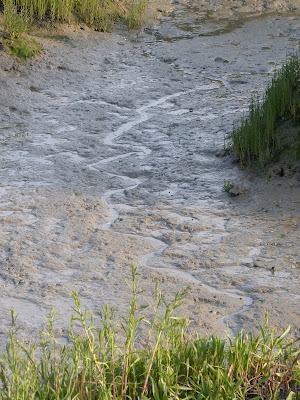I have learnt so much from just two chapters and I thoroughly recommend this book if this is a subject that interests you too. We hear so much about the moon's gravitational pull on the earth and how that creates tides. But did you know that the sun also has a gravitational pull. How have I lived all these years and not realised?! Suddenly, so many things have become clear and as well as learning a lot it is also an enjoyable book to read.
And as I read the book this morning, I was suddenly had an idea for a project. So for the next month I plan to visit the river every day at about the same time. Naturally life goes on and there will be days I miss, but I'm looking forward to getting involved and seeing what comes from this.
And to start, I have unwrapped a beautiful handmade book that a friend recently sent me. It has a sea chart cover and watercolour painted pages that representing water. It's just perfect! I will make notes of all the interesting facts and things I learn. I knew I would find a special use for this book!
The purpose of my river visits are to observe and connect with my experience. Because, we can miss so much when our thoughts distract us. These are the times when our mind can be in a different time or place, and so it is my intention to practice being present and to awaken all my senses.
Today I paid attention to:
- The tide lines, as these mark the highest level of the water.
- Flotsam - what gets left behind along the tide line.
- Wind direction and speed - It was a light breeze today but it was interesting to notice that it blew in the opposite direction from the flow of tide. This was deceptive, as on first glance you'd be mistaken to think the tide was coming upstream, but the photo below shows otherwise.
- The flow of water - being mudflats and estuary this makes for interesting features. I was reminded in 'How to Read Water' that when water runs through narrow channels it becomes faster and more active. I saw this for myself, and could see the directional flow. The boats on their mooring can tell you this too, as their bow always points to where the water is coming from. But today they were stranded on the mud, the water a mere puddle around their keels.
- The current tide - it happened to be at it's lowest at the time of my visit. Probably the lowest water I have ever observed, although that might be because I was paying proper attention today rather than just noticing it as low tide. I realised that if I had boots on I could probably wade across easily. Many years ago, before a school was built this side of the river, children used to have to cross to the other side to go to school. They'd be ferried across by boat at high tide, and come across in a horse and cart at low tide. What a fun way to go!
- Relation to the sun and moon - today is a New Moon so I couldn't have chosen a better time to start my project. This is purely coincidental and not planned!
- Plant and animal life in and along the edge of the river - I was lucky to see a pair of egrets, and as always, the large flock of resident swans came up the causeway to see if I had any food. For the first time, I became aware of the funny padding sound that their feet make on concrete, and how their feet are reptile-like in appearance. I always admire the swathes of sea lavender and the reeds blowing in the breeze. Today was no exception.
- How the water makes channels and gradually changes course - I love this landscape and have always been fascinated by this, but today I was even more attentive. I looked for small hollows in the mudflat, and others that have grown deeper. And I saw how eventually a new water course has cut through, or a mudflat is separated to form an island. I also paid attention to the stickiness of the mud. In places there was water still lying on the surface, or making a small channel. Most of the mudflats are covered with course grass and sea plants. But one was partly exposed, the surface cracked and crusty. Perhaps it was baked by todays sun, because I am certain it is covered by each incoming tide. I will have to look on future visits.
I will use my photos as a record and I plan to make a book to keep them in. Today's photo collection numbered 200+ but that's because it was low tide and I could see all the different landscapes and features. My main focus will be to record the tide levels, and learn to read the water. Of course I won't be an expert in 30 days, but I should know a whole lot more than I do now!
So I'll be back with more photos and progress soon.
So I'll be back with more photos and progress soon.
Thank you for visiting...














